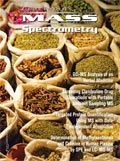Article
Special Issues
Spectroscopy Supplements
Unraveling the Links Between Diet and Human Health Using LC–MS-MS
We recently spoke to Gary Duncan and Wendy Russell of the Rowett Institute of Nutrition & Health in Aberdeen, Scotland, about the significance of phytochemical bioavailability to human health and the important role of liquid chromatography linked to tandem mass spectrometry (LC–MS-MS) in their research.
We recently spoke to Gary Duncan and Wendy Russell of the Rowett Institute of Nutrition & Health in Aberdeen, Scotland, about the significance of phytochemical bioavailability to human health and the important role of liquid chromatography linked to tandem mass spectrometry (LC–MS-MS) in their research.
Why are you using a quantitative metabolomics approach to study diet and human health?
Russell: We only need to look around us to see that nutritional-related disorders such as obesity, diabetes, cardiovascular disease, and some cancers are emerging as a public health crisis, particularly in Scotland. Understanding the balance between diet and human health is vital, if we are to establish evidence for the provision of healthy food. As chemists, it is clear to us that we must understand the complexity of the human diet, the availability of compounds from the food matrix, and how these are absorbed and transformed in the body. Without this information it will be impossible to relate dietary composition with the overall impact of diet on human health.
Duncan: For the first time, advances in analytical methodology can provide this information and we have adopted a quantitative metabolomics approach to achieve this. Genomic analysis provides an understanding of predisposition to disease and proteomics informs on disease occurrence. Metabolomics has always been an excellent predictor of disease and is equally likely to deliver information on the status of human health.
How important is phytochemical bioavailability to human health and in food and beverage analysis?
Russell: Our analysis of the diet considers the major macronutrients (carbohydrate, protein, and fat) and micronutrient minerals and vitamins. However, the non-nutrient phytochemicals are considered to contribute to the prevention of many diet-related diseases (1). These are thought to be preventative based on their bioactive properties (that is, anti-oxidants and anti-inflammatories). One important mechanism appears to be through their anti-inflammatory activity, as low-grade chronic inflammation appears to be a critical component of disease development and progression (2). We provide detailed information on the phytochemical profiles of both the diet and dietary-derived metabolites in the body (3). This can inform the food and beverage industry to provide healthier products to the market in the form of improved commonly consumed ready meals, as well as regularly consumed snacks and drinks.
What challenges have you faced in this work?
Duncan: It is important for us that we use a targeted approach that includes a comprehensive range of metabolites that are considered both beneficial and detrimental to human health. This requires the analysis of a complex and increasingly growing number of metabolites. The analytical methodology is challenging and constantly evolving as we introduce new groups of compounds to our data set. In addition, we want to report how these compounds are transformed (both metabolically and by the gut bacteria) and distributed in the body (4,5). This not only requires the identification of the derivatives of the parent phytochemicals, but also the analysis of highly variable biological samples, where sensitivity and stability are important issues.
With bowel disorders on the rise, have you seen a trend toward a more healthy diet and knowledge of what is essentially "good for you" in your research?
Russell: Lifestyle choices and, in particular, lack of physical activity and poor diet are contributing factors to the high incidence of bowel disease worldwide. There is increasing evidence that the gut microbiota play a major role in these disorders and that the dietary metabolites they produce might be a contributing factor. We have shown from human studies that high protein diets that do not contain enough dietary fiber are likely to be detrimental to gut health in the long term (5). In these studies, we demonstrated using both targeted and liquid chromatography–tandem mass spectrometry (LC–MS-MS) that there were increased hazardous metabolites and less anti-inflammatory and cancer-protective compounds present in the gut when people ate these high-protein, low-fiber diets. We are currently running similar studies that are funded by the Scottish Government; The Food, Land, and People Programme is investigating components of the Scottish diet, predominantly fruits, vegetables, and cereals (6). By understanding the composition of these foods, the impact of plant breeding, and food production processes we aim to provide healthier and more sustainable food.
Why is liquid chromatography coupled to tandem mass spectrometry (LC–MS-MS) your analytical method of choice?
Duncan: Since its inception and, more significantly, its commercialization, LC–MS has played an integral part in the analysis, identification, and quantification of natural products. The power of the LC–MS technique, or more accurately liquid chromatography combined with tandem mass spectrometry (LC–MS–MS), lies in its ability to separate complex, biological mixtures, and for pure compounds to be ionized directly from the liquid phase into the gaseous phase, using the mass spectrometer to identify or quantify the compound.
In the late 1980s, several groups had developed LC–MS methods to identify metabolites in various subclasses of phytochemicals but it wasn't until the late 1990s that the true value of LC–MS, in the analysis of phytochemicals, started to become more apparent. Papers were published utilizing the capability of the technique to perform large-scale screening of phytochemicals in complex mixtures.
With the development of ever more powerful and sensitive mass spectrometers, the analysis of phytochemicals using mass spectrometry diverged into two distinct categories: The metabolomic–qualitative approach using high-resolution mass spectrometry to identify large numbers of metabolites from a single analysis, and the targeted–quantitative approach looking at known metabolites using triple-quadrupole mass spectrometry. As the hardware on mass spectrometers has improved (detectors now have the capability of measuring as little as 1 pg on column), so has the power of the computers and software that operate them. Faster scan speeds with shorter dwell times (the time the system spends looking at an individual mass) lead to more analyses being performed during a single scan and now a large number of metabolites from many different types of groups can be measured by LC–MS with unparalleled sensitivity. Our work has focused on the quantitative analysis of phytochemicals utilizing the selectivity of the multiple reaction monitoring (MRM) method with triple-quadrupole mass spectrometry to look at a large and diverse range of dietary constituents found in both the food we eat and in the human body. LC–MS-MS provides the ideal platform to measure these metabolites, which are sometimes only present in small concentrations, with the high-throughput analysis required for large-scale human studies (8).
Where will your research into human health and food analysis take you in the future?
Russell: Understanding the human metabolic phenotype (the metabotype) will allow us to assess the specific contribution of diet on the metabolites bioavailable in the body and their translated effect on general health. We anticipate that by correlating the individual compounds found in foods with their observed bioactivity, we will be able to provide the knowledge required for the food and beverage industry to provide healthier and more sustainable food for a growing and increasingly unhealthy population. Up until now, we have focused on characterizing the metabotype, in terms of exogenous metabolites, predominantly of dietary origin. Our more recent work has identified the impact of diet on certain endogenous molecules produced by the human body (prostanoids, lysophosphatidylinositols, and bile acids) (9,10). From an analytical perspective, this work is likely to be more challenging, as the molecules are generally present in very low concentrations, are less stable, and are subject to inter-individual variation. From a dietary standpoint, we aim to provide food which will benefit health across the population. However, an understanding of endogenous metabolism may highlight a future role for more personalized nutritional strategies.
References
(1) W.R. Russell and G.G. Duthie, Proc. Nutr. Soc. 70(3), 389–96 (2011).
(2) W.R. Russell, S.H. Duncan, and H.J. Flint, Proc. Nutr. Soc. 72(1), 178–88 (2013).
(3) W.R. Russell, L. Hoyles, H.J. Flint, and M. Dumas, Curr. Opin. Microbiol. 16(3), 246–54 (2013).
(4) W.R. Russell, S.H. Duncan, L. Scobbie, G. Duncan, L. Cantlay, A.G. Calder, S.E. Anderson, and H.J. Flint, Mol. Nutr. Food Res. 57(3), 523–35 (2013).
(5) W.R. Russell and S.H. Duncan, TrAC, Trends Anal. Chem. 52, 54–60 (2013).
(6) W.R. Russell, S.W. Gratz, S.H. Duncan G. Holtrop, J. Ince, L. Scobbie, G. Duncan, A.M. Johnstone, G.E. Lobley, R.J. Wallace, G.G. Duthie, and H.J. Flint, Am. J. Clin. Nutr. 93(5), 1062–1072 (2011).
(7) M. Neacsu J. McMonagle, R.J. Fletcher, L. Scobbie, G. Duncan, L. Cantlay, B. de Roos, G.G. Duthie, and W.R. Russell, Food Chemistry 141(3), 2880–6 (2013).
(8) W.R. Russell and S.H. Duncan, MS-Based Methodologies to Study the Microbial Metabolome in Foodomics (John Wiley & Sons, Inc., Hoboken, New Jersey, 2013).
(9) W.R. Russell, J.E. Drew, L. Scobbie, and G.G. Duthie BBA: Molecular Basis of Disease 1762(1), 124–130 (2006).
(10) J.M. Moreno-Navarrete, V. Catalán, L. Whyte, A. Díaz-Arteaga, R. Vázquez-Martínez, F. Rotellar, R. Guzmán, J. Gómez-Ambrosi, M.R. Pulido, W.R. Russell, M. Imbernón, R.A. Ross, M.M. Malagón, C. Dieguez, J.M. Fernández-Real, G. Frühbeck, and R. Nogueiras, Diabetes 61, 281–291 (2012).

Newsletter
Get essential updates on the latest spectroscopy technologies, regulatory standards, and best practices—subscribe today to Spectroscopy.



